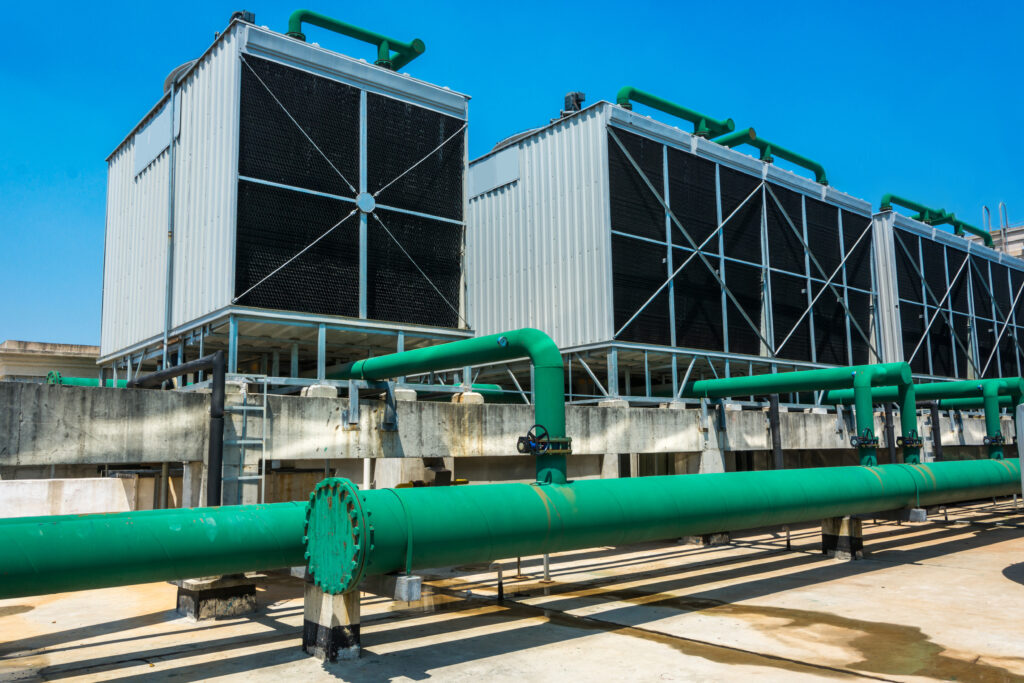Types of Cooling Tower Systems and Their Benefits[Infographic]

Cooling tower systems remove heat from various industrial processes or HVAC systems by transferring the heat to the atmosphere through evaporation. The type of cooling tower system used depends on the specific application and the desired outcomes. Open circuit cooling towers are efficient and cost-effective, closed circuit cooling towers reduce water consumption and contamination risk, while hybrid cooling towers offer the benefits of both systems. Different types of cooling tower systems are available, each with unique benefits.
What are Cooling Tower Systems?
Cooling tower systems work by taking in hot water or other fluids and cooling them down by exposing them to the atmosphere. The hot fluid is sprayed through nozzles onto the fill material, where it falls through the fill and air is drawn through the water, resulting in evaporation and heat transfer. The cooled fluid is then collected at the bottom and pumped back into the process. Cooling tower systems are commonly used in power plants, chemical and petrochemical plants, HVAC systems, and other industrial applications that generate large amounts of heat. They come in different types, including open circuit, closed circuit, and hybrid cooling towers, each with unique benefits depending on the specific application.
Open circuit cooling towers
Open circuit cooling towers, or evaporative cooling towers, work by taking in hot water and cooling it down by exposing it to the atmosphere. The hot water is sprayed through nozzles onto the fill material, where it falls through the fill and air is drawn through the water, resulting in evaporation and heat transfer. The cooled water is collected at the bottom and pumped back into the process. Open circuit cooling towers are commonly used in power plants, chemical and petrochemical plants, and HVAC systems. The benefits of open circuit cooling towers include high efficiency, low operating costs, and low environmental impact.
Closed-circuit cooling towers
Closed-circuit cooling towers use a heat exchanger to transfer heat from the hot water to a secondary fluid, such as water or glycol. The secondary fluid is then circulated through the cooling tower and cooled by the atmosphere. The cooled secondary fluid is then circulated back to the heat exchanger to absorb more heat. Closed circuit cooling towers are commonly used in HVAC systems, data centers, and process cooling applications. The benefits of closed-circuit cooling towers include lower water consumption, reduced water treatment requirements, and reduced risk of contamination.
Hybrid cooling towers
Hybrid cooling towers combine the features of open and closed-circuit cooling towers, offering both benefits. The hot water is first cooled in a closed loop, then transferred to an open circuit tower, further cooled by evaporation. Hybrid cooling towers are commonly used in power plants, chemical and petrochemical plants, and HVAC systems. The benefits of hybrid cooling towers include higher efficiency, reduced water consumption, and reduced environmental impact.

How to Increase the Performance of Your Cooling Tower Systems
There are several ways to increase the performance of cooling tower systems, which can help to improve their efficiency, reduce energy consumption, and prolong their lifespan. Here are some methods:
Maintain proper water chemistry: Cooling tower water should be properly treated to prevent scaling, fouling, and corrosion, which can reduce heat transfer efficiency and damage the cooling tower equipment. Regular water testing and chemical treatment help maintain the proper water chemistry.
Increase airflow: Increasing the airflow over the cooling tower fill material can improve the heat transfer rate, which results in better cooling performance. This can be achieved by installing fans or cleaning the existing fans to ensure they operate at maximum efficiency.
Clean the tower regularly: Regularly cleaning the cooling tower fill material, basin, and other components can improve heat transfer efficiency and reduce the risk of corrosion and fouling. It is recommended to clean the tower at least twice a year.
Upgrade to high-efficiency components: Upgrading the cooling tower components, such as fans, motors, and drives, to more efficient models can reduce energy consumption and improve overall performance.
Implement a maintenance program: Regular maintenance of the cooling tower system, including inspections, cleaning, and repairs, can help to identify and address issues before they cause significant problems or reduce performance.
Consider water treatment alternatives: Alternative water treatment methods, such as side-stream filtration or chemical-free treatment systems, can help to reduce water consumption, improve water quality, and improve overall cooling tower performance.
Overall, improving the performance of a cooling tower system requires regular maintenance, proper water treatment, and consideration of efficiency upgrades and alternative methods. By implementing these strategies, the performance and efficiency of a cooling tower system can be improved, resulting in reduced energy consumption and operating costs and increased lifespan of the equipment.
Complete Engineered Solutions
If you’re looking for a way to cool process equipment or an HVAC system, it makes sense to choose the best type of system—one that is as effective and efficient as possible. Some applications will benefit from a specific type of cooling tower: open circuit cooling towers, which cost far less than other systems. Plus, there are other factors to consider when choosing a system: will the water be used for drinking or irrigation later? Will the cooling tower be located indoors or outdoors? Armed with these variables, you can make an informed choice about which system works best for you.
Suppose your company is looking to expand on their current cooling tower system and reduce the costs of product maintenance while at the same time lowering onsite expenses. In that case, consider getting in touch with Complete Engineered Solutions. They offer complete solutions for all your air compressor needs, from nitrogen generation to chillers and vacuum systems. Achieving these requirements leads to a healthy return on your investment, which is why so many clients have chosen them as their partner for industrial equipment supply over the past three decades.
